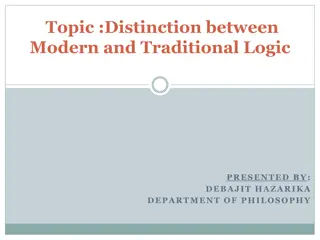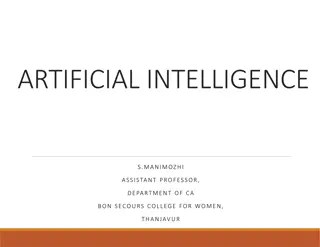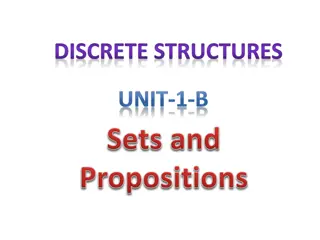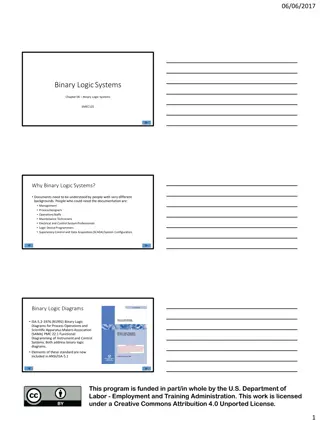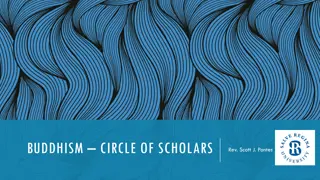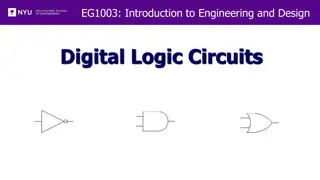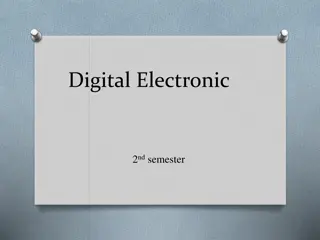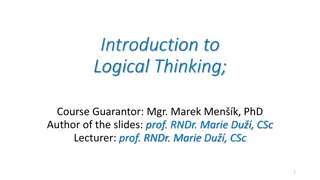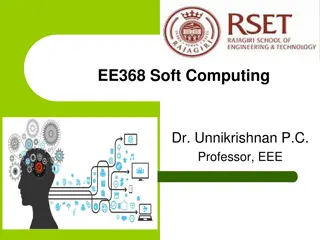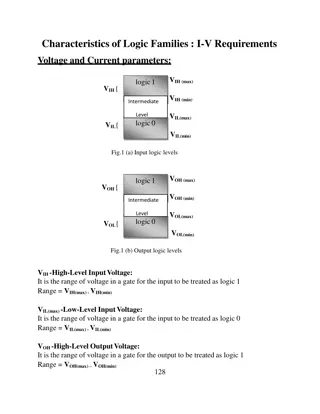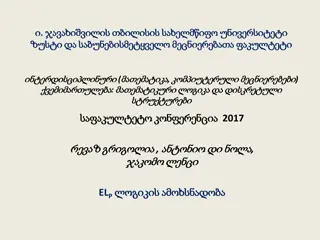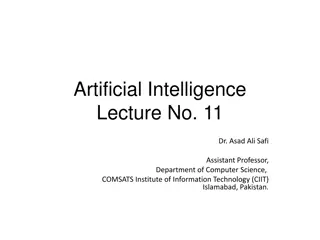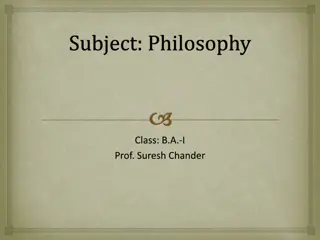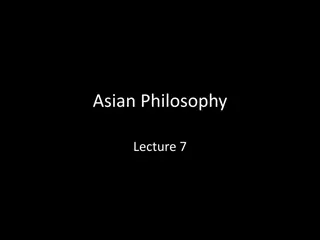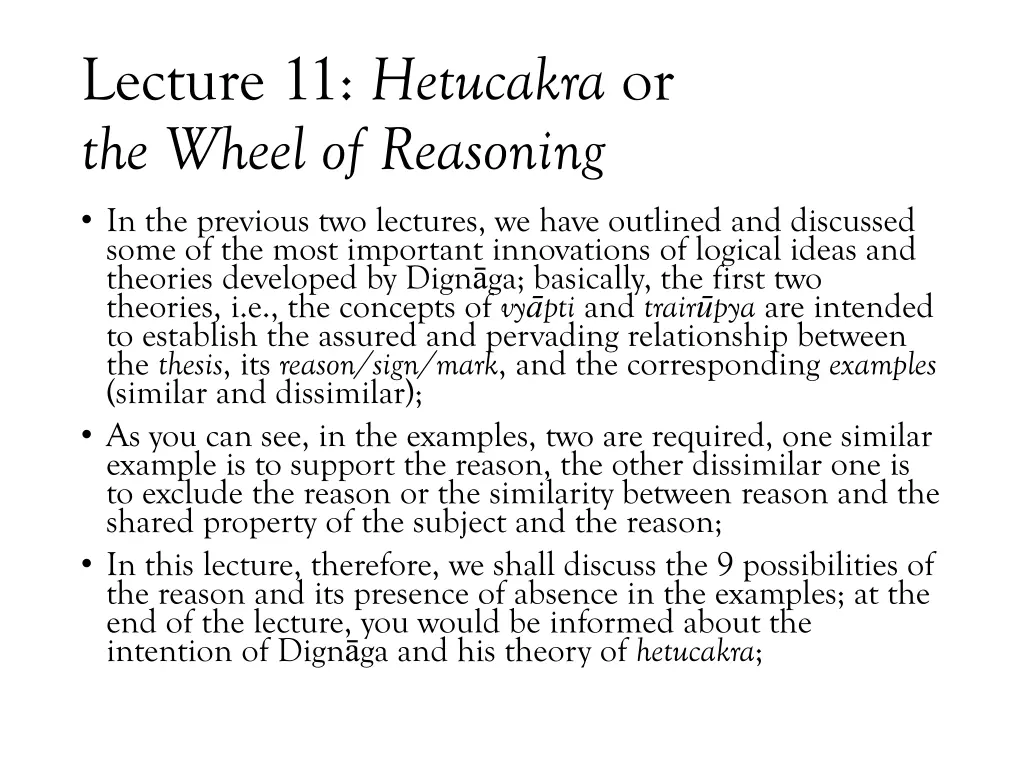
Hetucakra: Theory of Reasoning and Logical Innovations by Dignāga
Explore the theory of Hetucakra by Dignāga focusing on logical innovations and reasoning concepts like vyāpti and trairpya. Understand the relationships between thesis, reason, and examples, delving into 9 possibilities of reason and its presence in examples.
Download Presentation

Please find below an Image/Link to download the presentation.
The content on the website is provided AS IS for your information and personal use only. It may not be sold, licensed, or shared on other websites without obtaining consent from the author. If you encounter any issues during the download, it is possible that the publisher has removed the file from their server.
You are allowed to download the files provided on this website for personal or commercial use, subject to the condition that they are used lawfully. All files are the property of their respective owners.
The content on the website is provided AS IS for your information and personal use only. It may not be sold, licensed, or shared on other websites without obtaining consent from the author.
E N D
Presentation Transcript
Lecture 11: Hetucakra or the Wheel of Reasoning In the previous two lectures, we have outlined and discussed some of the most important innovations of logical ideas and theories developed by Dign ga; basically, the first two theories, i.e., the concepts of vy pti and trair pya are intended to establish the assured and pervading relationship between the thesis, its reason/sign/mark, and the corresponding examples (similar and dissimilar); As you can see, in the examples, two are required, one similar example is to support the reason, the other dissimilar one is to exclude the reason or the similarity between reason and the shared property of the subject and the reason; In this lecture, therefore, we shall discuss the 9 possibilities of the reason and its presence of absence in the examples; at the end of the lecture, you would be informed about the intention of Dign ga and his theory of hetucakra;
Dignga and Hetucakra When we discussed about the trair pya, the concept is about the three aspect of the reason; or in other words, it is about the relationship between the subject/thesis/property of the subject and the reason, and then the relationship between the reason and the examples; as we mentioned, the term pak a, s dhya (meaning: s dhyadharma), and pratij should be understood contextually; Before we proceed, notice that: [mountain possesses fire = pratij ; mountain = pak a, fire = s dhya/ s dhyadharma; but notice that both pak a and s dhya are known as subjects, but apparently mountain is not the entire subject because here we are talking about a fire in the mountain or a mountain possesses a fire; so the subtle difference is that one subject is about mountain and the other one is about the property of the mountain mountain possesses a fire or the locus of fire, which is located somewhere in the mountain];
Trairpya, vypti and hetucakra: in the theory of trair pya, vy pti (thesis and mark/reason) and hetucakra (reason and examples) are discussed; then in the hetucakara, the reason is explored; by extension and association, vy pti is also explained; so in the end, the theory of trair pya triggers off the motion of the chain gears system the logical reasoning method and the validity of the inference process;
From vypti to hetucakra As we have just discussed, the trair pya tries to establish two connections: between the thesis/subject and the reason, and between the reason and the examples; With the first connection, the theory of vy pti/pervasion or invariable concomitance is important; for example, according to the theory of invariable concomitance, fire and smoke, or sound, conditionality and impermanence not only connected, but both would exist or occur concomitantly; if there is one, there would be the other; so the theory of vy pti or invariable concomitance tries to guarantee a constant relationship between the subject/thesis and the reason; Then in the second part of the trair pya, the theory tries to establish the relationship between the reason and the example by a twofold method the present and the absent; in a detailed outline, Dign ga came out 9 situations that the reason-examples relation can be observed, which is collectively known as hetucakra;
Hetucakra: this is a important invention of Dignga and is generally translated as wheel of reason; but as Bimal Matilal points out, it means a group or a set rather than a circular wheel; (1998:106) because although the term refers to the wheel, it actually consists of 9 possibilities through which the validity, cogent level and soundness of the logical reasoning can be observed; below, s = sapak a, v = vipak a, + = present/presence, = absent/absence; = both present/presence and absent/absence; s+/ v+ s+/ v s / v s /v s+/v s /v+ s / v+ s /v s /v
Hetucakra: below are some explanations of the hetucakra; more detailed analysis would be given in the following slides; and you should also read the treatise and detailed explanatory notes in the document provided to you; As we have just mentioned, hetucakra means wheel of reasoning; but in reality, it means a set of 9 possibilities about reason and the two types of examples; 2 types: sapak a or similar example and vipak a or dissimilar example; because these two types of examples need to be discussed with the reason/sign or mark, the are 3 elements here: hetu, sapak a and vipak a; 3 possibilities: there would be 3 possibilities in the above 3 elements as presence, absence and both presence and absence; so in total, there are 9 possibilities; Of course Dign ga was criticized because he failed to consider two other possibilities: hetu is absent in both sapak a and vipak a; (Matilal, 1998:9) but that position is less significant than what the hetucakra achieved;
1: the sign/reason is present in both sapaka and vipaka; please note first of all, the reason that sound it permanent because it is knowable is too broad to be observed from the two examples; for instance, although sound is permanent because it is knowable such a space, the property of being knowable is too broad because both examples space and pot are knowable and there is no specific characteristic to be observed as permanent or impermanent; Sound is permanent because it is knowable S: such as the space/sky V: such as a pot
2: the sign/reason is present in the sapaka and absent in the vipaka; as you may notice, this is generally the standard requirements of the hetu and its presence and absence in the examples; here, the reason is specifying the unique property of impermanence conditioned-ness; and by extension, the conditionality of the pot and the consequent impermanent nature are ascertained; the unlikeness of sky, not produced and permanence would accordingly exclude the possibility of not produced-ness and impermanence; so the inference is valid; Sound-non- eternal-produced S: like a pot V: unlike the space/sky
3: the sign/reason is present in the sapaka but both present and absent in the vipaka; this one is slightly similar with the first situation, where in the dissimilar example, reason/mark is both present and absent; because of the uncertainty about absence in the dissimilar example, its function makes the example less clear; the dissimilar examples below show that lightning is impermanent because produced by effort; but the sky is not produced and permanent; with these two broad unlike examples and the opposing properties permanence and impermanence, the thesis is not well proved; Sound is produced by effort because it is impermanent Such as a pot Unlike the lightning and the sky
4: the sign/reason is absent in the sapaka and but present in the vipaka; this is of course the reverse situation of the normal situation we have discussed so far; below example shows that with the reason/sign and the corresponding examples do not share the required properties, the outcome would be contradictory; sound is permanent and the reason it is produced cannot be reconciled, so is sky/space; this also results in the irreconcilability of dissimilar example a pot; Sound is permanent because it is produced Like the space/sky Unlike a pot
5: the sign/reason is absent in both the sapaka and the vipaka; in this case, there is a point of irrelevance between the reason and the similar example; sound, non- eternality and audibility may be true but audibility is not a universal property of non- eternality and sound; and it is rather irrelevant to compare this with space; so here the audibility is to narrow a property to guarantee the validity of the inference; Sound is non-eternal due to its audibility Like the space Unlike a pot
6: the sign/reason is absent in the sapaka and but both present and absent in the vipaka; here, the reason contradicts its thesis by stating that sound is permanent because of being produced by effort; please note here that as we mentioned, this is according to Buddhist theory of dependent co-arising; otherwise it would be different; so in similar example, space is either permanent or not produced by effort; and pot and lightning are produced and not produced by effort; here effort seems to suggests artificial effort, not the natural effort; because lightning may be not produced by human effort but it needs the natural efforts conditions to be effective; Unlike pot and lightning Like space Sound is permanent because it is produced by effort
7: the sign/reason is both present and absent in the sapaka and but present in the vipaka; here, it is the reverse order of the thesis and reason; sound it not produced because it is impermanent; so in the similar example, lightning is impermanent & not produced; sky/space is permanent & not produced; on the other hand, pot is produced & it is impermanent; Unlike a pot Like the lightning and space Sound is not produced because it is impermanent
8: the sign/reason is both present and absent in the sapaka and but absent in the vipak a; sound is impermanent because it is produced; here the reason/sign and the examples are almost standard requirements similar to the 2ndsituation in the hetucakra, except that the sign is both present and absent in the similar examples; Sound Non- Eternal Unlike the space/sky Like a pot Like the lightning Effort Reason (produced by effort) Sapak a Vipak a
9: the sign/reason is both present and absent in the sapaka as well both present and absent in the vipak a; in this case, sound is permanent because it is incorporeal (non- physical), which is a property to broad to be specified; for instance, while atom is impermanent but corporeal, space is incorporeal but permanent; action and pot can be viewed in a similar manner; the result is then inconclusive; Sound is permanent because it is incorporeal Like atom and space Unlike action and pot
Summary and facts-check As you can see from the previous slides, the hetucakra is to outline the possibilities of the reason and its relationship with the thesis as well as the examples; we may ask one question: why reason is so important? It is because it is the link, the proof and the sign/mark of the whole inference process; So in the set of 9 possibilities, only the 2ndpossibility, that is, present in sapak a and absent in vipak a, is the standard trair pya; the 8thpossibility, that is, both present and absent in the in sapak a but solely absent in vipak a, might be valid; but because the lightning may be understood as not produced by (human) effort, if it is used as a similar example, then it is difficult to argue because it should be permanent; if it is understood as impermanent because it is not produced by effort, then it should go to the next category the dissimilar example; this should be kept in mind when we try to understand the 8thpossibility; All right, that would be all for this week; any questions, let me known!
Exercises/assignments Do the following exercises and submit them via email (chuanqing@bcs.edu.sg) to me by 5:00 pm, on 18th November (Wednesday); as usual, please send the exercises of the two courses (Buddhism and Economics & Introduction to Buddhist Logic) together in one Word doc. file; The inference: Diamond is permanent because it is very hard; like a steel rod, but unlike a wooden stick; The questions: 1, Do you think the above inference is valid or invalid according to Buddhist theory of conditioned co-origination? 2, Can you identify the trair pya in the above inference?

